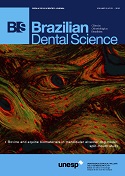Low-concentrated nonvital bleaching effect on bond strength of composite resin restorations
DOI:
https://doi.org/10.14295/bds.2016.v19i3.1273Abstract
Objective: To investigate if short-term dentin bleaching with low-concentrated substances affects the bond strength of immediate resin composite restorations. Material and Methods: The buccal surfaces of fifty molar crowns were ground for dentin exposure and randomly assigned into 5 groups (n=10), according to the following treatments: sodium perborate + water; sodium perborate + 6% hydrogen peroxide; 6% hydrogen peroxide; 35% hydrogen peroxide (positive control), or no bleaching agent (negative control). The specimens were immediately restored with resin composite. Seven days after treatments, the shear bond test was performed in a universal test machine at a crosshead speed of 0.5 mm/min. Data were analyzed using ANOVA and Tukey’s HSD test (? = 0.05). Results: The shear bond strength mean values for the negative control group were higher than all experimental and positive control groups (p < 0.000), whose differences were not statistically significant (p > 0.05). Conclusion: Short-term dentin bleaching with sodium perborate+water, 6% hydrogen peroxide, or sodium perborate mixed with 6% hydrogen peroxide reduced the shear bond strength of immediate resin composite restorations.
Keywords
Resins, synthetic; Hydrogen peroxide; Shear strength; Esthetics; Tooth.
Downloads
Downloads
Published
How to Cite
Issue
Section
License
Brazilian Dental Science uses the Creative Commons (CC-BY 4.0) license, thus preserving the integrity of articles in an open access environment. The journal allows the author to retain publishing rights without restrictions.
=================




























